Two of the Royal New Zealand Air Force’s four King Air 350 aircraft, modified with an electro-optic and infra-red camera, and surveillance radar sensor suite, have been taking on a maritime surveillance role since the retirement of the P-3K2 Orions last year, with the latest mission off the coast of Westport. Squadron Leader Craig Clark, the Operations Flight Commander at No. 42 Squadron, is the tactical co-ordinator for this mission. After a crew briefing that covers the mission brief, weather, and “ditching plan” in case of engine failure (a very low risk), the crew sets off to the King Air on the tarmac. Lifejackets donned and, unable to stand upright in the small compartment, the crew slithers into their seats and strap into their four-point harness.
From Ohakea the King Air climbs to a cruising altitude of 22,000 feet where turbulent weather and a bit of ice was replaced by smooth flying and blue skies. It isn’t long before the stunning snow-capped Kaikoura ranges are visible on their way south to Westport. When patrolling the King Air can fly at low speeds tucking itself under the cloud layer – as low as 250 feet when necessary. It can fly for about 3.5 hours making it perfect for patrolling around the coast of New Zealand out to 100 nautical miles, or for investigating a particular vessel or small groups of vessels at a greater distance. The King Air is a more cost-effective alternative to the P-8A Poseidon for coastal patrolling as it’s a much smaller plane and uses less fuel and fewer crew needed to operate it.
The radar and camera are fitted below the belly of the plane and once engaged the camera sits lower than the aircraft’s wheels. The drag on the plane can be felt as the camera swivelled to capture its target. With its ability to fly low and slow it can patrol close to the coast and take high quality video and imagery. This ability has proven invaluable in maritime surveillance. Together, the Defence Force and Ministry for Primary Industries (MPI) monitor vessels operating within New Zealand’s Exclusive Economic Zone (EEZ) – one of the largest in the world at 1.7 million square kilometres. The role of the air warfare specialist is to locate vessels using radar and pass that intelligence on to the air warfare officer to decide whether to look more closely at the vessel.

The video of the vessel actively fishing, along with the vessel name and serial number are sent to MPI for them to look at and follow up, if necessary. Interestingly, the first vessel picked up by radar is NIWA’s RV Tangaroa, New Zealand’s only ice strengthened and dynamically positioned deep-water research vessel. Equipped for ocean science, exploration and marine engineering, Tangaroa provides a sophisticated environmental survey and ocean science platform throughout the South Pacific, Southern Ocean and Antarctica. Four vessels are located during the patrol mission. The speck on the horizon that could barely be seen with the naked eye becomes startingly clear using the cameras. Once the King Air drops to about 300 feet and flies closer, it’s very easy for the crew to watch people in slicks throwing bycatch overboard and handling the nets. Some species of fish are also discernible.
The vessels located during this mission (with the exception of the Tangaroa) were all stern trawlers – fishing vessels that drag huge nets through the water to catch fish. The King Air aircraft is also used for the multi-engine training Air Force pilots need after becoming proficient on the single engine aircraft the T-6C Texan. It also provides training for air warfare officers using airborne consoles and a mission management system installed in the KA350 cabin. Military aviators also receive training on the senor suite – the on-board electro-optic and infra-red camera and a single array multi-mode surveillance radar. Training on the King Air also promotes the transfer of skills to other aircraft (such as the P-8A) of crew integration, multi-engine handling, organisational awareness, advanced training, international operations, captaincy and surveillance.
The King Air 350 (KA350) is a light, twin engine, fixed wing, nine passenger, commuter aircraft. Our Air Force has four KA350s in its fleet, introduced as part of the Air Crew Training Capability project (ACTC). The KA350 has been modified for the NZDF to allow the transport for nine passengers, Air Warfare training and sensor suite training. The ACTC project also introduced ground-based training systems for both pilots and air warfare officers. Air Warfare Officer training is conducted using airborne consoles and a mission management system installed in the KA350 cabin. Pilot training can be conducted in any of the three configurations. There are two ship-sets of consoles allowing Air Warfare Officer training to be conducted on two KA350 aircraft concurrently. The sensor suite, that is fitted to two KA350s, consists of an Electro-Optic and Infra-Red camera and a single array multi-mode surveillance radar. The sensor suite is intended to be utilised for sensor operator training in the future.
















